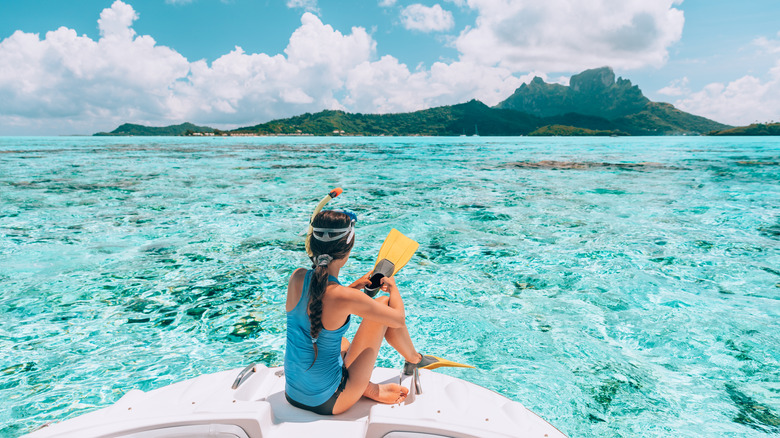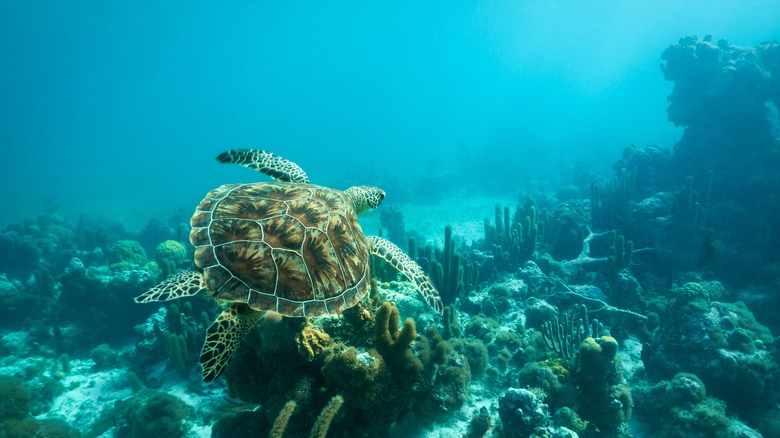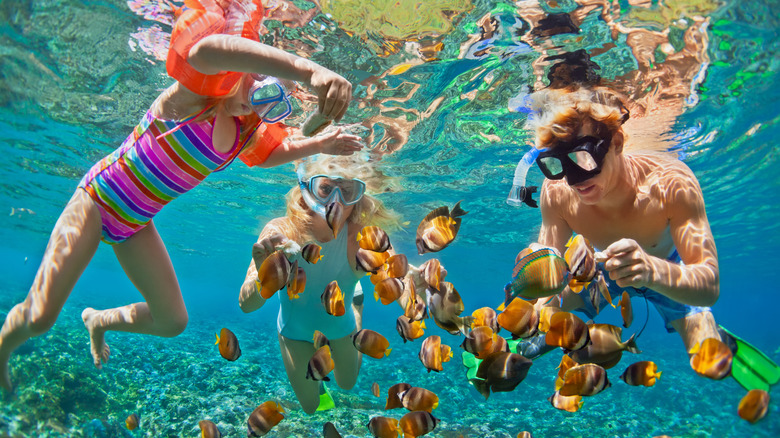This Caribbean Snorkeling Destination Is One Of The Best Thanks To Vibrant Coral Reefs
The Caribbean is synonymous with clear blue waters and vibrant coral reefs — perfect for snorkelers and divers. But with 26 island countries nestled in this beautiful stretch of the Caribbean Sea, which one is ideal for underwater exploration? Turks and Caicos is the answer. This idyllic archipelago is one of the best snorkeling destinations in the world, drawing adventure-seekers and nature enthusiasts from all around.
Turks and Caicos consists of 40 different islands and cays, only a handful of which are inhabited. These islands are positioned on the world's third largest coral system — the Florida Keys Reef Tract – providing a habitat for a diverse range of marine life. The consistently warm weather, averaging 81 degrees Fahrenheit, 350 days of sunshine, and excellent visibility (often exceeding 100 feet) make it ideal for snorkeling year-round. The water temperatures are balmy: between 74 to 78 degrees Fahrenheit in winter and 82 to 84 in the summertime. Currents are mild and predictable.
Marine life thrives in the turquoise waters surrounding Turks and Caicos, from larger species, such as stingrays, dolphins, and sea turtles, to smaller ones, like lionfish and groupers. There are sharks, specifically grey reef and nurse sharks, with occasional hammerheads and more. But don't worry — there is an incredibly low shark attack rate here, with only three recorded attacks (all non-fatal). The water is clear because of the low quantities of debris and plankton — so you can get a real good look at all the underwater wonders.
Prime snorkeling spots in Turks and Caicos
One of the most famous snorkeling spots in Turks and Caicos is Smith's Reef in Providenciales. This site is easily accessible from the shore at Turtle Cove Marina and offers snorkelers a chance to explore a dazzling underwater landscape. The reef features a series of coral gardens that showcase an array of fan coral, colorful sponges, and other sea creatures such as sea turtles, eagle rays, and even squid.
Another must-visit location is Bright Reef, also located in Providenciales. Bright Reef is a safe, family-friendly destination for snorkeling that is perfect for beginners and those with young children. You can easily walk into the water and begin snorkeling, and the clear waters are home to various fish, stingrays, and, occasionally, graceful green turtles. The protected area at the center of the reef is off-limits to encourage healthy coral growth — swimming and snorkeling are restricted to the perimeter.
For those willing to venture further, the uninhabited island of Little Water Cay offers untouched beauty and a quieter snorkeling environment. Also known as Iguana Island (for being a sanctuary for the endemic and endangered rock iguana), it is surrounded by lush coral reefs that are particularly rich in marine life due to the lower human impact. If you're interested, you can also arrange a custom trip to snorkel at one of Turks and Caicos' 1,000 wreck sites. This includes the HMS Endymion, Cessna 401, and the Lucky Lady, which are all in Salt Cay.
Conservation and tips for your visit
The government of Turks and Caicos is committed to preserving this natural wonder. Several marine parks and reserves have been established to protect the delicate coral reefs and their inhabitants. These protected areas help sustain the biodiversity and ensure that snorkeling remains a viable activity in the future. Unfortunately, the biggest threat is stony coral tissue loss disease (SCTLD), which affects many types of corals and spreads rapidly. Enforcement of ecological protection laws, however, has been a challenge. The non-profit Turks and Caicos Reef Fund has been doing important conservation, education, and preservation work — they accept donations and volunteers. Snorkelers are encouraged to practice responsible tourism by not touching the coral or disturbing marine life.
To make the most of your underwater adventures, always check local weather forecasts before heading out. The best snorkeling conditions are calm, sunny days. Bring reef-safe sunscreen to protect the coral from chemicals that cause bleaching, have plenty of water to stay hydrated, and wear a rash guard or T-shirt to protect against the sun. Even on cloudy days, UV rays can penetrate the water surface and cause sunburn. If you plan on booking a snorkeling tour at some of the smaller islands, know that having some cash is crucial for your Turks and Caicos trip. Big Blue Collective, an eco-adventure company, offers small-group snorkeling expeditions on boats that produce less noise and pollution (and never anchor on reefs) without any provision of single-use plastics on the tour.


